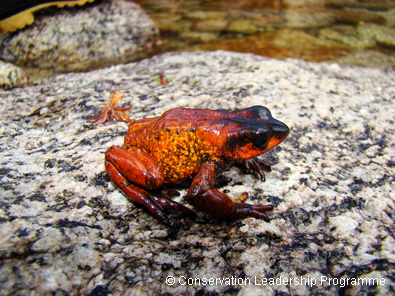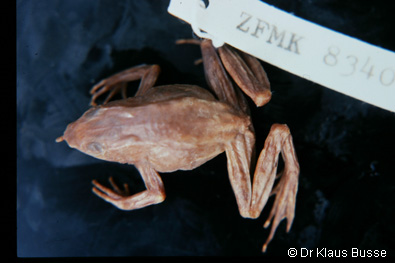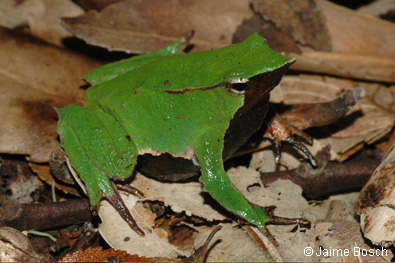A group of young scientists recently discovered that a species of frog which had not been seen for 14 years is still surviving in a remote region of Colombia. The Project Atelopus team, who’s work is supported by the Conservation Leadership Programme, were surveying in the Sierra Nevada de Santa Marta mountains in northern Colombia when they found the frog. The species is only found in this small mountainous region, where it lives in high altitude páramo grassland habitat, and can even survive in snow-covered areas.
The Carrikeri harlequin frog (Atelopus carrikeri) is listed on the IUCN Red List of Threatened Species as Critically Endangered, because a population decline of more than 80% was projected as a result of the effects of the virulent chytrid fungus, Batrachochytrium dendrobatidis.
The Carrikeri harlequin frog, which was recently rediscovered by the Project Atelopus team working in Colombia.
Chytrid fungus results in the disease amphibian chytridiomycosis, and although not well understood, is known to be causing devastating declines in numerous amphibian populations worldwide. In Central and South America the disease seems to affect high-altitude species in particular, including many relatives of the Carrikeri harlequin frog from the genus Atelopus, and in eastern Australia the fungus is the suspected cause of the extinction of three evolutionarily distinct amphibians – the southern gastric brooding frog (Rheobatrachus silus), the northern gastric brooding frog (Rheobatrachus vitellinus) and the southern day frog (Taudactylus diurnus).
Over 200 amphibian species are known to have been infected by chytrid fungus worldwide. You can find out more about chytrid and its effects on the world’s amphibians, including declines in some top ranked EDGE Amphibian species, on the amphibian disease page of the EDGE of Existence website.
One of the current EDGE Focal Amphibians thought, like the Carrikeri harlequin frog, to have been affected by chytrid fungus is the Chile Darwin’s frog (Rhinoderma rufum). This species was relatively common until 1978, but in a very short period of time suffered massive population declines and has not been seen since 1980. Although suspected, it is yet to be confirmed that chytrid fungus was the cause of these population declines.
There are no known photos of a living Chile Darwin’s frog – only images of preserved specimens are available.
The Chile Darwin’s frog is classified as Critically Endangered – Possibly Extinct by IUCN, and is highly evolutionarily distinct with just one close relative, the Darwin’s frog (Rhinoderma darwinii), itself classified as Vulnerable to Extinction. These two species have an unusual method of parental care – the male takes the fertilised eggs into his vocal sac where the young grow. When they reach a certain stage of development the father carries his offspring to a stream where he expels them from his mouth. Here they complete metamorphosis.
The only close relative of the Chile Darwin’s frog, the Darwin’s frog, looks very similar to our EDGE Focal Species.
Unfortunately, the Chile Darwin’s frog may now be extinct, and the EDGE Amphibians team are currently fundraising for an expedition to discover whether a population does still exist. The team will survey the former range of the Chile Darwin’s frog looking for any surviving populations, and will assess the cause of the species’ population declines by recording threats at survey sites and carrying out swabs on other amphibians in the region to test for chytrid fungus. We hope that we will be lucky, like the scientists who found the Carrikeri harlequin frog, and discover that the Chile Darwin’s frog is still surviving in the wild.
If you would like to support this expedition to search for this unique, but sadly possibly extinct species, please donate here.


